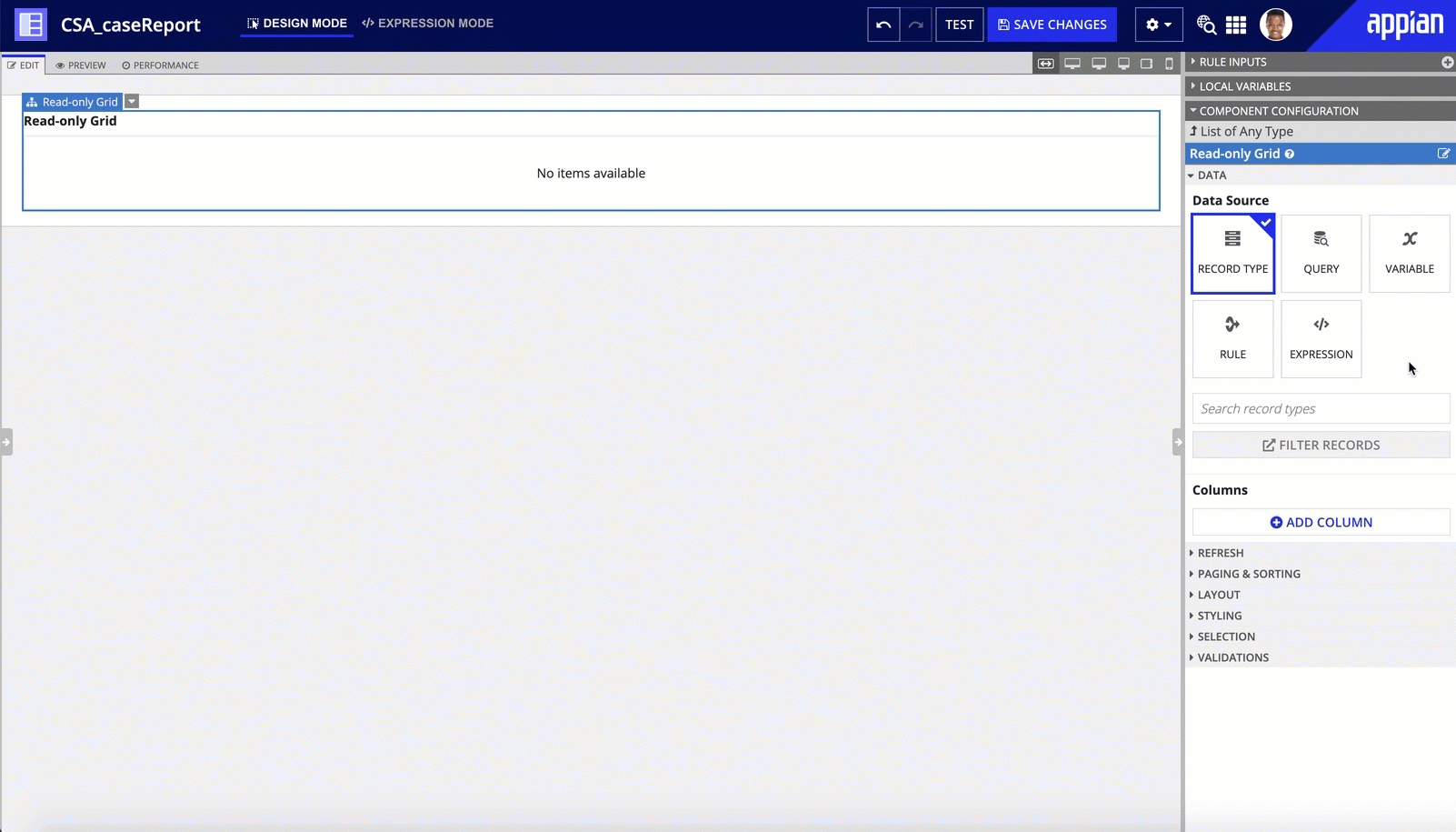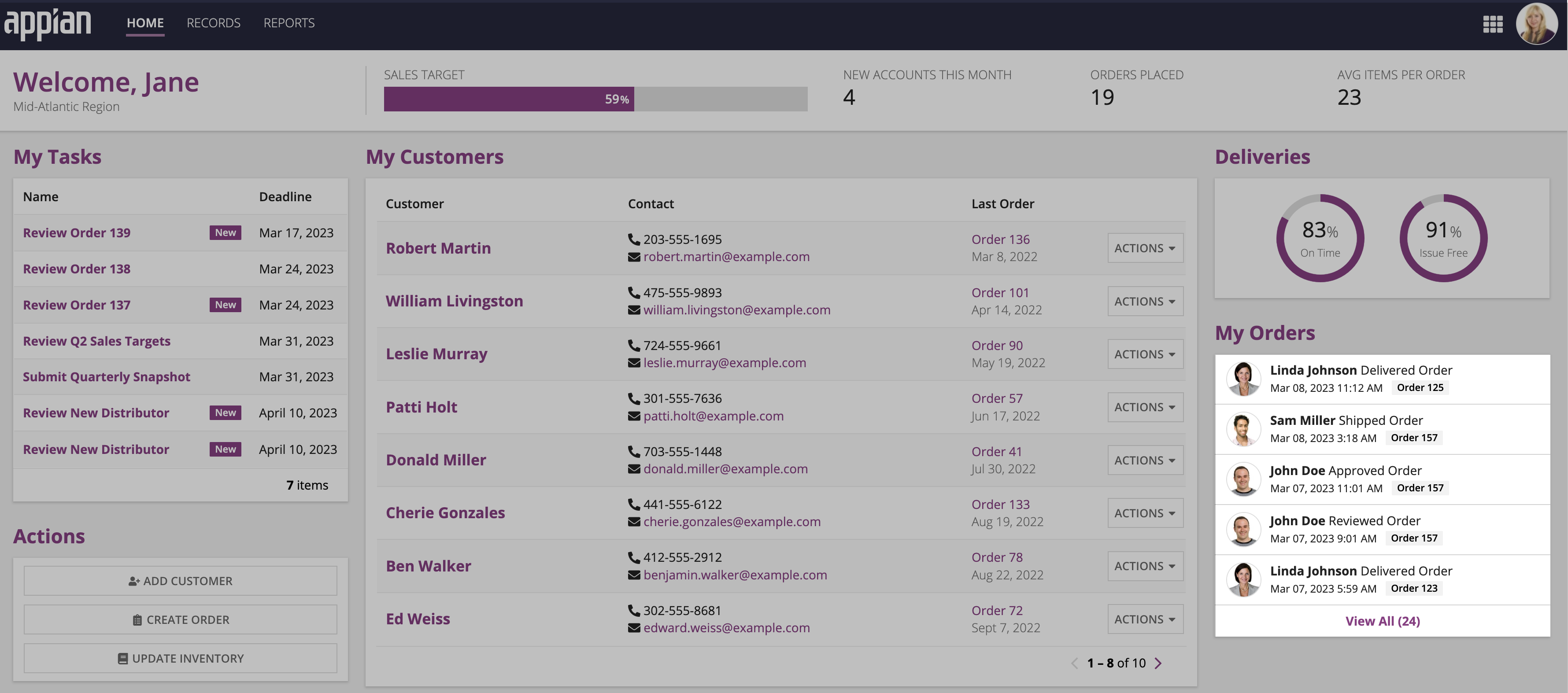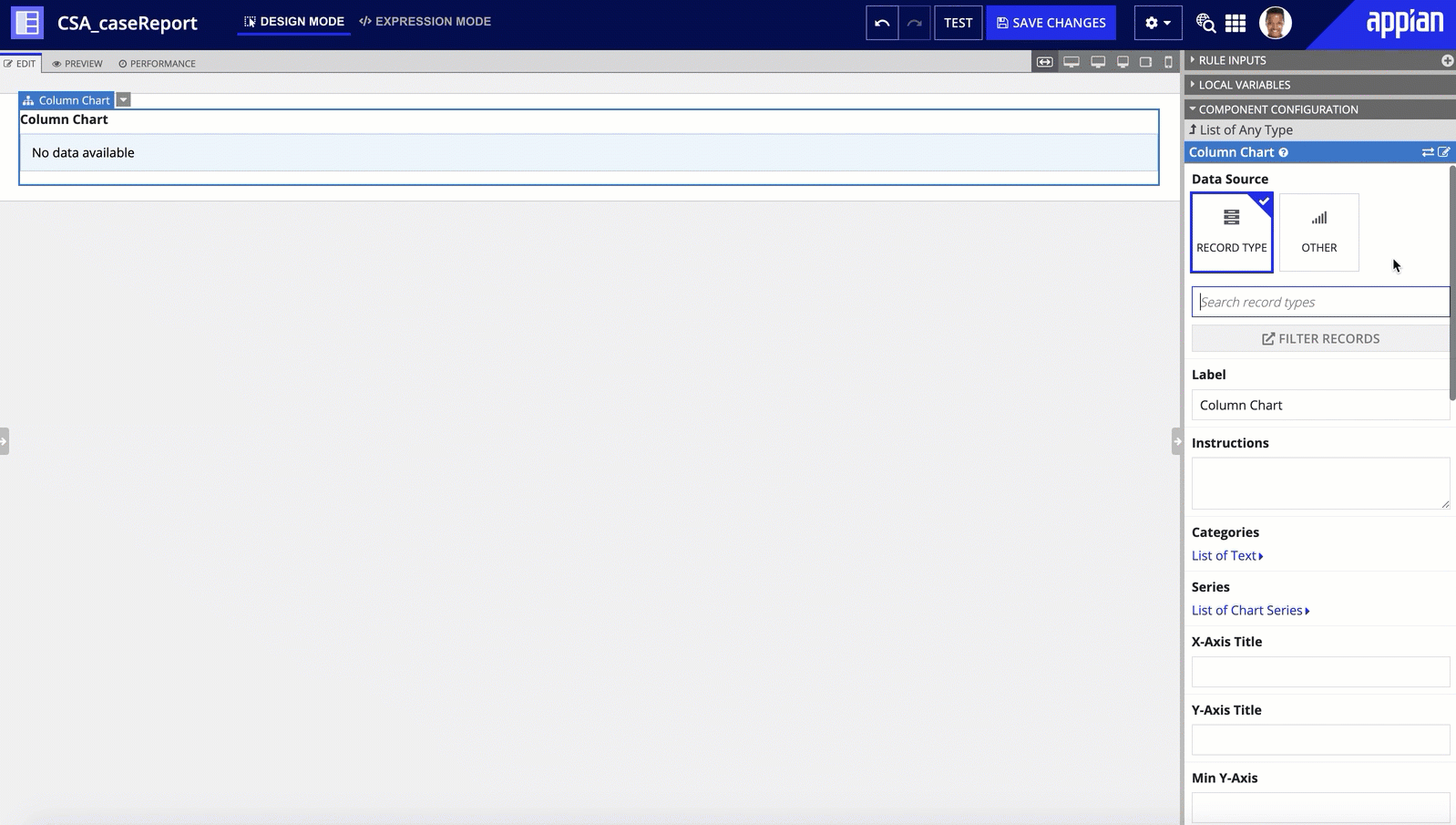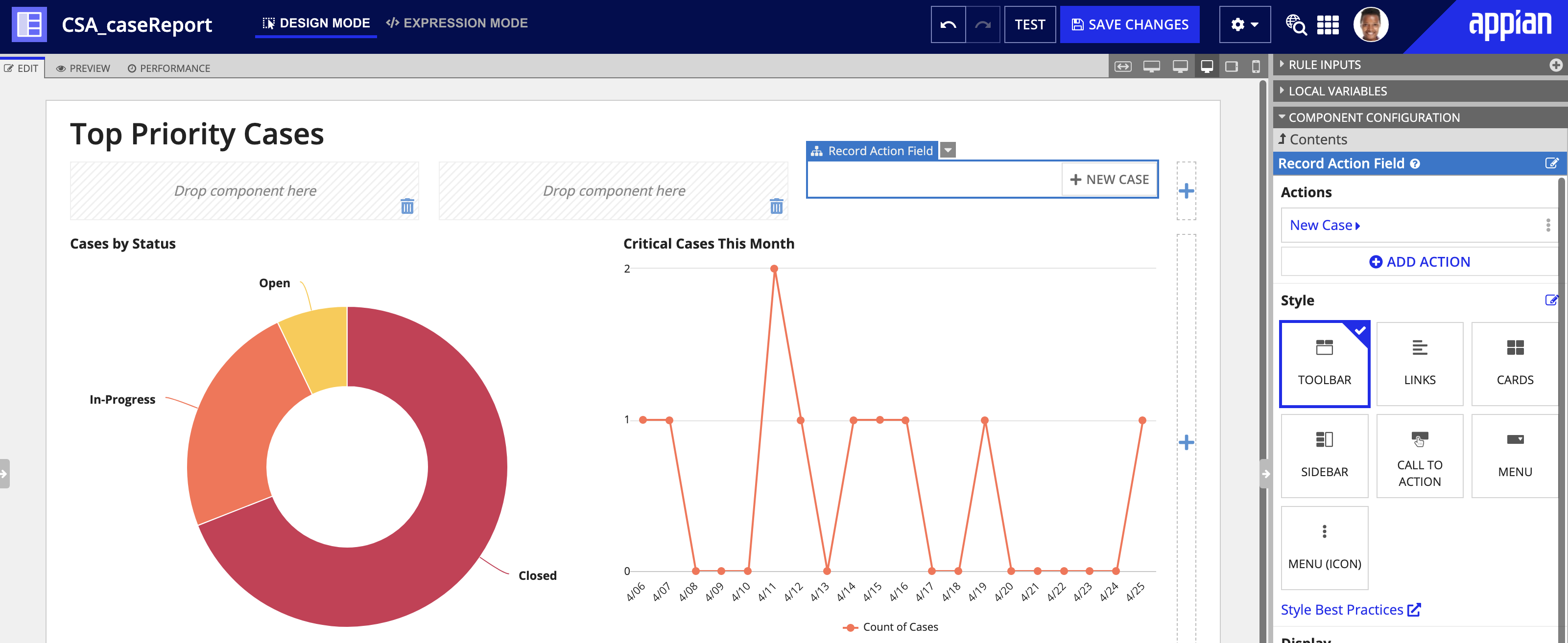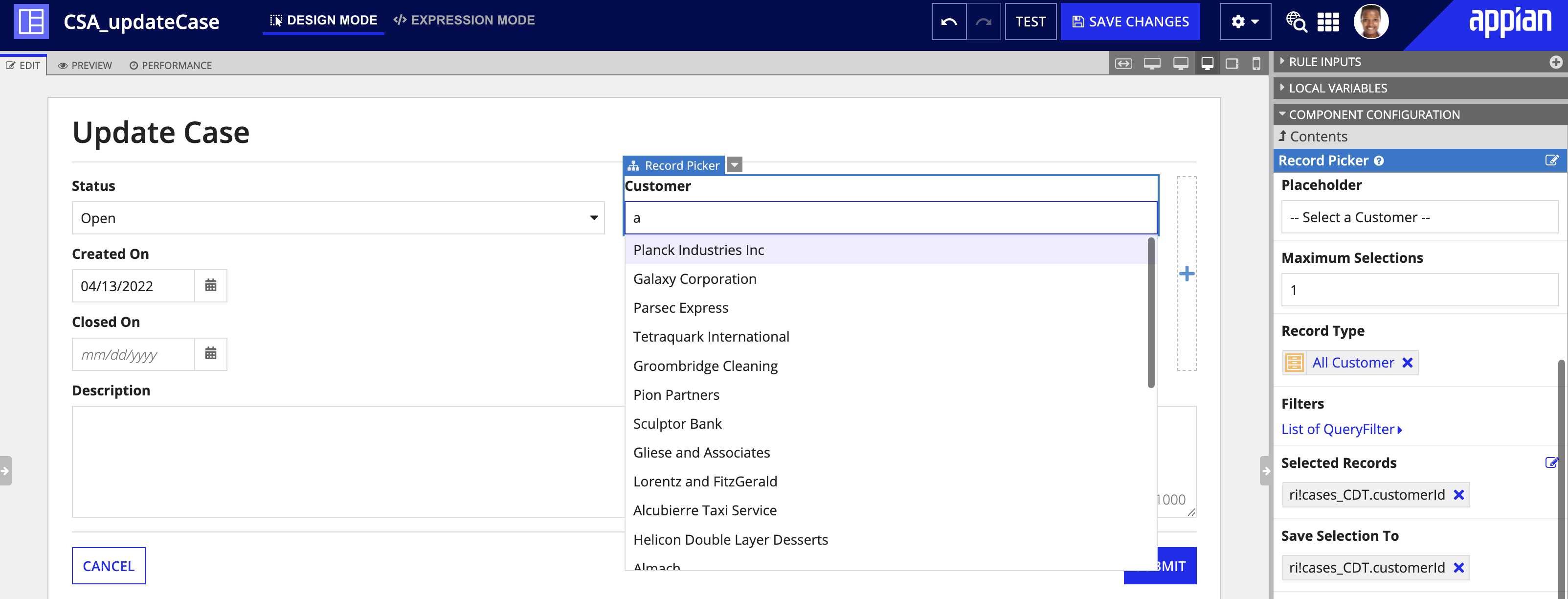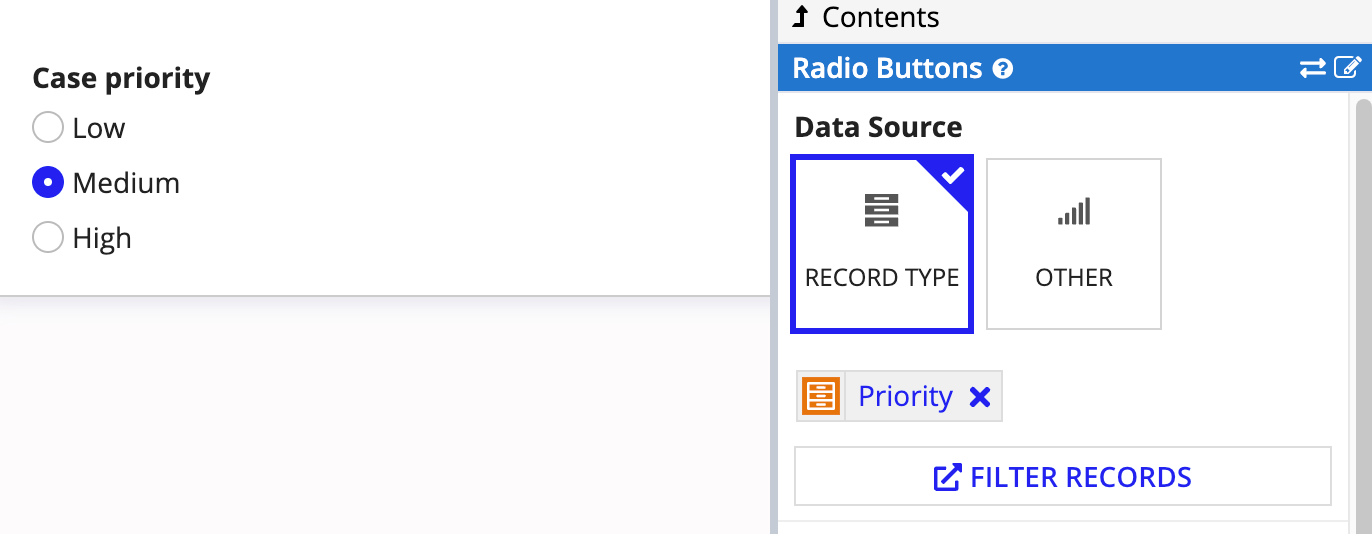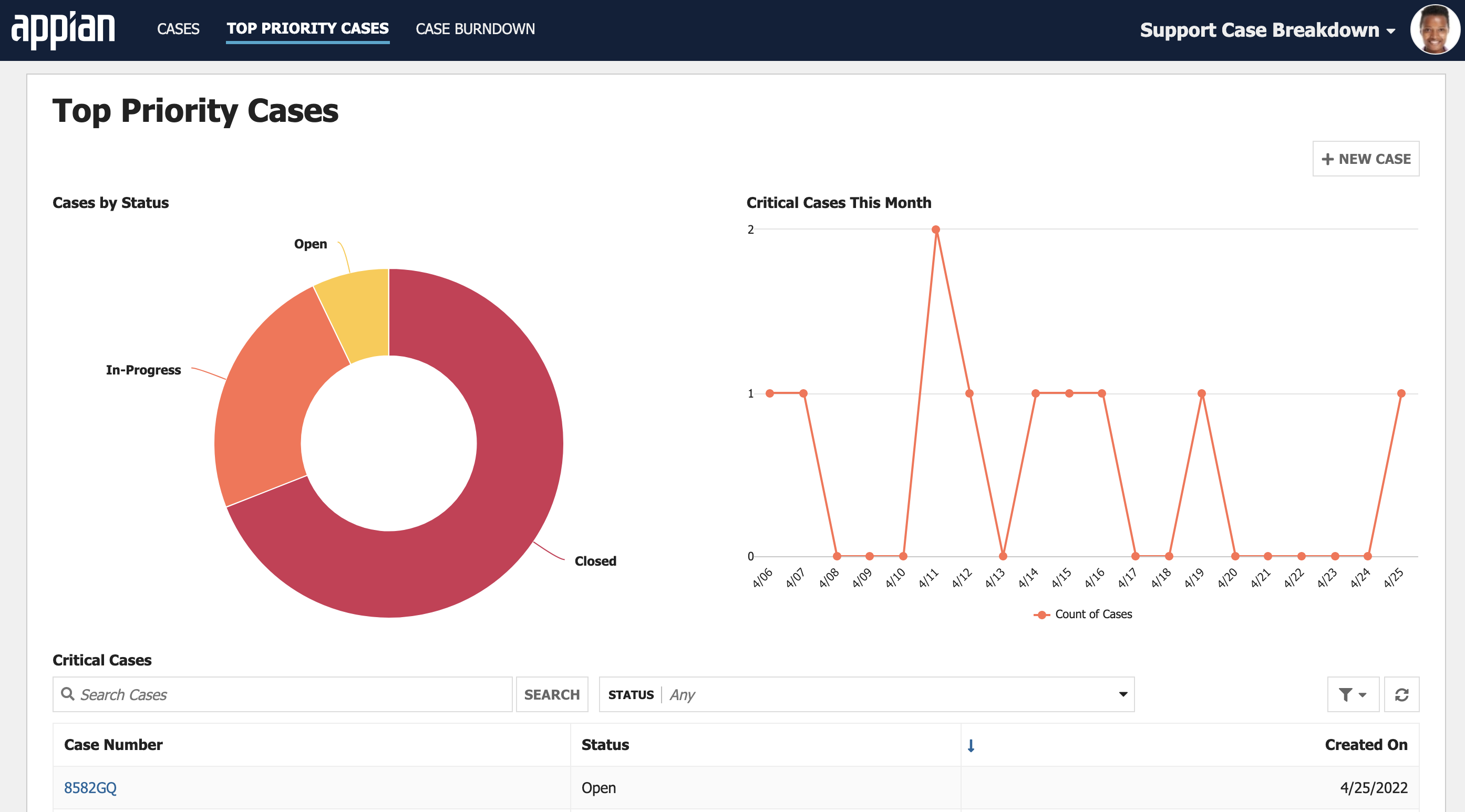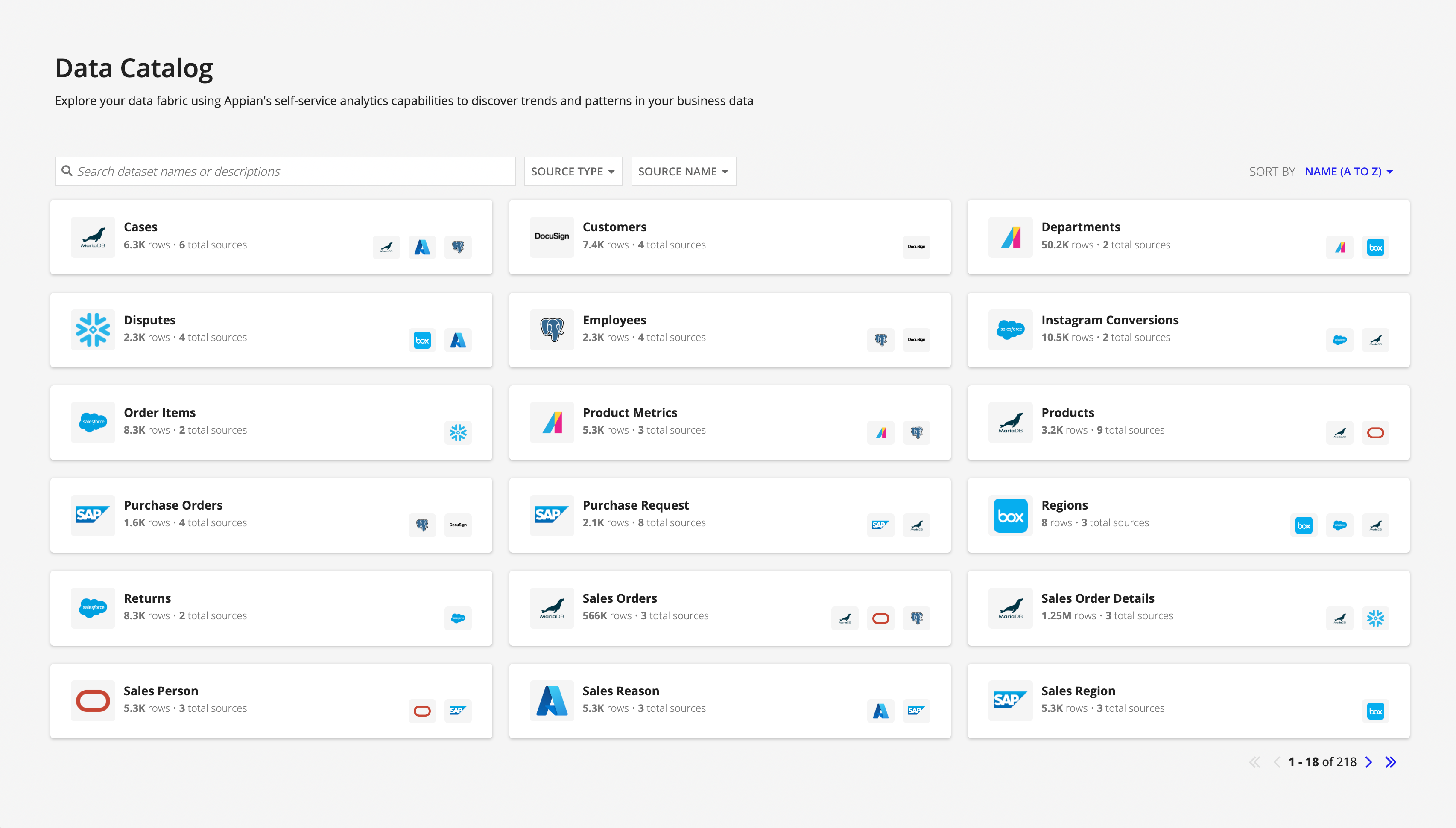This page explains the different places where developers and end users can reference record data.
OverviewCopy link to clipboard
Appian Records makes it easy to work with your data throughout your applications. Once you've configured your record type, you can use it to power interface components, pass data in a process model, and display record data in sites. You can even allow end users to leverage your record data using Appian's self-service analytics capabilities.
Tip: Review your record type's security to ensure the right users can view the right data.
Interface componentsCopy link to clipboard
There are numerous interface components that allow you to use a record type as the data source. These records-powered components make it quick and easy to build powerful reports and interfaces:
- Read-only grid
- Event history list
- Charts
- Record actions
- Record links
- Record picker
- Selection components
Read-only gridCopy link to clipboard
You can easily pull record data into a read-only grid by choosing the record type as the grid's data source. Records-powered grids allows you to reuse features configured on your record list such as user filters, search configurations, record actions, and export to Excel.
By default, the grid will apply the record list style and format. You can then customize your grid by creating new grid columns, where you can reference record fields or related record fields, and apply different display options to present your data.
In expression mode, you can configure the grid's data source using a!recordData or a!queryRecordType, and use fv!row with bracket notation to pass the record field values into the grid.
Related patternsCopy link to clipboard
-
Aggregate Data and Conditionally Display in a Chart or Grid (Reports, Charts, Query Data, Grids, Records): Aggregate data and conditionally display it in a pie chart or grid. In this pattern, we will calculate the total number of employees in each department and display it in a pie chart and a read-only grid. Then, we'll use a link field to conditionally display each component.
-
Aggregate Data on a Date or Date and Time Field (Reports, Query Data, Grids, Records): Aggregate data, specifically the total number of employees by date.
-
Conditionally Hide a Column in a Grid (Grids, Conditional Display): Conditionally hide a column in a read-only grid when all data for that column is a specific value.
-
Configure a Chart Drilldown to a Grid (Charts, Grids, Query Data, Records): Displays a column chart with aggregate data from a record type and conditionally shows a grid with filtered records when a user selects a column on the chart.
-
Delete Rows in a Grid (Grids): Delete one or more rows of data in a read-only grid.
-
Display Last Refresh Time (Auto-Refresh, Grids, Records): Display the last time the interface was updated, either based on a user interaction or a timer.
-
Filter the Data in a Grid (Grids, Filtering, Records): Configure a user filter for your read-only grid that uses a record type as the data source. When the user selects a value to filter by, update the grid to show the result.
-
Filter the Data in a Grid Using a Chart (Charts, Grids, Filtering, Records): Display an interactive pie chart with selectable sections so that a user may filter the results in a grid.
-
Limit the Number of Rows in a Grid That Can Be Selected (Validation, Grids, Records): Limit the number of rows that can be selected to an arbitrary number.
-
Show Calculated Columns in a Grid (Formatting, Grids, Records): Display calculated values in columns in a grid.
-
Sync Records using a Record Action (Records, Grids): Configure a record action with the Sync Records smart service so users can sync a set of records on demand.
-
Top Customers and Their Latest Order (Records, Reports, Grids): This pattern illustrates how to create a grid that shows the top paying customers, their latest order, and their total sum of sales.
Event history listCopy link to clipboard
The event history list component allows you to display your record events in a list or in a timeline format. This component makes it easy to view your business operations at a glance, especially when you leverage the generated Event History record type to configure it.
ChartsCopy link to clipboard
It's easy to build powerful reports when you use a record type as the source of your charts.
Simply choose your chart, and specify the record type to use as your data source. Appian will then query your data for you and automatically display the results in the chart. You can then modify the chart's grouping and measures to determine what data to query from the record type and how to display the results on the chart.
If your record type leverages record type relationships, you can easily reference related data by hovering over the relationship name in the list of available record fields.
If you start building your chart and find that you need to calculate or summarize your existing data to display the right information, consider creating custom record fields on your record type to calculate these values and store them in a new record field. Then, you can reference your custom record fields to display, sort, or filter data in your chart.
Related patternsCopy link to clipboard
-
Aggregate Data and Conditionally Display in a Chart or Grid (Reports, Charts, Query Data, Grids, Records): Aggregate data and conditionally display it in a pie chart or grid. In this pattern, we will calculate the total number of employees in each department and display it in a pie chart and a read-only grid. Then, we'll use a link field to conditionally display each component.
-
Aggregate Data and Display in a Chart (Reports, Charts, Query Data, Records): Aggregate data, specifically the total number of employees in a given department, to display in a pie chart.
-
Aggregate Data by Multiple Fields and Display in a Chart (Reports, Charts, Query Data, Records): Aggregate data by multiple fields and display it in a stacked column chart. In this pattern, we will calculate the total number of employees for each title in each department and display it in a stacked column chart.
-
Aggregate Data using a Filter and Display in a Chart (Reports, Charts, Query Data, Filtering, Records): Aggregate data, specifically the total number of employees for each title in the Engineering department, to display in a bar chart.
-
Configure a Chart Drilldown to a Grid (Charts, Grids, Query Data, Records): Displays a column chart with aggregate data from a record type and conditionally shows a grid with filtered records when a user selects a column on the chart.
-
Dynamically Show Sales by Product Category Compared to Total Sales (Records, Reports, Charts, Filtering): This pattern illustrates how to create an area chart that dynamically displays sales generated by product category compared to total sales.
-
Filter the Data in a Grid Using a Chart (Charts, Grids, Filtering, Records): Display an interactive pie chart with selectable sections so that a user may filter the results in a grid.
-
Sales by Region (Records, Reports, Charts): This pattern illustrates how to create a bar chart that shows sales per sales region.
-
Total Orders Compared to Orders Purchased with Promo Codes (Records, Reports, Charts): This pattern illustrates how to create a column chart that compares the number of total orders and the number of orders that had at least one item purchased with a promo code.
Record actionsCopy link to clipboard
Once you add a related action or a record list action to your record type, you can reuse these actions in any report or form using the record action component.
This component gives you the flexibility to display record actions anywhere on the page, and even change the way the button appears on the interface.
With a record action component, you can easily add a list of record actions, and even reference record actions from different record types.
See a!recordActionField() and a!recordActionItem() to learn how to configure a record action component.
Record linksCopy link to clipboard
After you configure your record views, you can easily link to these views using record links. For example, in your Customer record list, you could add a record link on the name field and use fv!identifer to pass in each customer's ID. Now, when a user clicks on the customer name, the link will go to the Summary view associated with each customer.
1
2
3
4
5
6
7
8
9
a!linkField(
links: {
a!recordLink(
label: fv!row[recordType!Customer.fields.name],
recordType: recordType!Customer,
identifier: fv!identifier
)
}
)
Copy
Record links can be used in tags, charts, grids, hierarchy browsers, images, link fields, milestones, pickers, and rich text. Using record links, you can allow users to easily discover more information with minimal effort.
See the record link component for more information.
Record pickerCopy link to clipboard
The record picker allows users to select one or more records from a record type using an autocompleting picker. This component is particularly useful when building forms to update or add new information to a record.
For example, if you want to open a new case for a customer, you can add a record picker on your form so you can select the customer name from the Customer record type. This prevents users from manually entering a customer name each time they log a case, and it provides an alternative to building and maintaining a constant to display a list of all customer names.
See the record picker component for more information.
Selection componentsCopy link to clipboard
The following selection components can be configured with a record type as their data source—a faster and simpler method than building a query or mapping parameters one by one:
These components are perfect for letting users pick a value from a set of record data.
For example, say you want to let users pick one or more options from a list of products and add them to an order. You can add a checkbox or multiple dropdown component and set it to use data from an Item record type.
If you want to let users pick one option from a list, like choosing the priority of a support case, you can add a radio button or dropdown component. This lets you control the available options without needing to set up a constant, and it prevents mistakes caused when people enter values manually.
Process modelsCopy link to clipboard
Record types can be used as variables in a process model. This allows you to use record data in your process model as a process variable or an activity class parameter.
You can use record types as process variables to manage the full lifecycle of your business data and power a variety of workflows. For example, record data can be used to:
- Update and sync changes using the Write Records and Delete Records smart services.
- Pass in data from a start form that uses a record type as a rule input.
- Sync external data changes using the Sync Records smart service.
- Examine record data to make decisions in a gateway node.
- Determine who needs to be informed of the process and send them an email or push notification.
See Create a new record using a process model for an example.
SitesCopy link to clipboard
In sites, you can associate record types with site pages.
When a site page is associated with a record type, the user sees the record list for the associated record type when accessing that page.
Display records on a siteCopy link to clipboard
To associate a record type with a site page:
- Create a site or open an existing site.
- Click Add Page.
- From the Type dropdown, select Record List.
- Use the Content dropdown to select a record type from the list of available records.
- Click OK.
Show record newsCopy link to clipboard
When you associate a record type with a site page, you can choose whether or not to show the News view on the records displayed on the site.
By default, a site is configured to show record news. This means that each record will have a view that displays the 20 most recent news events related to the record. However, the News view will only display on the site if Show News view is selected for the record type object.
See Define Record Views to learn more about configuring the display of default record views.
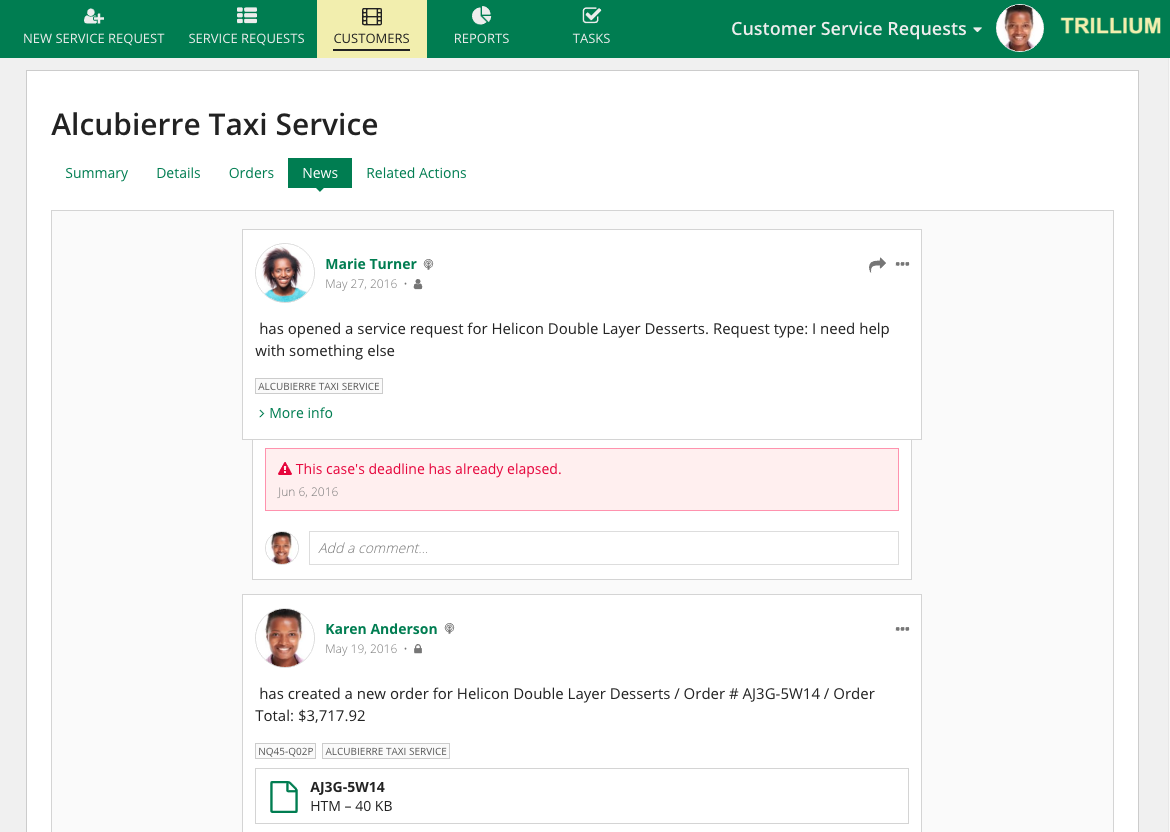
Self-service analyticsCopy link to clipboard
Self-service analytics allows business users to leverage your record data to build their own custom reports.
Users can explore your record types as datasets. By default, any record type with data sync enabled will be available as a dataset to end users.
Each dataset will inherit the record type object security and record-level security configured on the record type and its related record types—ensuring the right users only see the right data. If you've already secured these aspects of your record type, there's likely no additional configuration necessary.
Learn more about self-service analytics and how to prepare and secure data for end users.
TempoCopy link to clipboard
In Tempo, record types are displayed as a list of cards on the Records tab. Each record type has an associated icon and color.
By default, Tempo will display a preconfigured record type called Users. This record type contains a directory of all Appian users. To make changes to the Users record type, see Modify the User Record Type.
Users can click a record to view the record list.

Display records on TempoCopy link to clipboard
By default, new record types do not display on the Records tab in Tempo.
To display record types in Tempo:
- In your record type, go to Tempo.
-
Select the Show this record type on the records tab in Tempo checkbox.

- For Icon, select an icon relevant to your record type so that users can find it faster in the list.
- For Icon Color, choose a color to help differentiate your record type from others.
- Save your record type.
Note: As a best practice, you should hide a record type that defines reference or supplemental data that is only created and managed in the context of another record type. Hiding a record type does not prevent users from viewing a record's list or views in Tempo.

